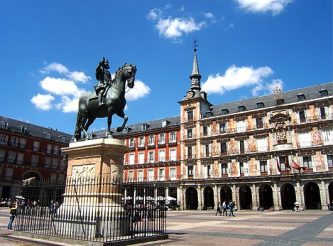GUEST POST OVERVIEW: History here. Get your history here! Thanks to our friend Aleix, I am proud to present a fascinating lesson on one of the most famous families in Madrid’s history: The Habsburgs.
“The Habsburg dynasty, known as ‘Los Austria’, is the family who reigned in Spain during the 16th and 17th century. This time span coincided with Spain’s golden era as the most powerful nation in Europe, and they left a legacy which can still be enjoyed in Madrid today.

Spain’s golden era came during the time that the Habsburg dynasty reigned, what the Spanish called Los Austria, since that was their origin. A total of five kings reigned during a period of just under 200 years. During this time, the kingdom of Spain also encompassed the kingdom of Portugal until the mid-17th century, and they also had strong colonial power all over the world.
The first Habsburg king was King Felipe I, who married the daughter of the Catholic Kings, Juana. He was king-consort but was established as king due to Juana being diagnosed with madness. He was known as Felipe the Handsome and had many lovers, which some say prompted his wife’s madness. He took over the kingdom in 1506 but died shortly afterwards of typhoid, although some say that he was poisoned by his father-in-law, Fernando II of Aragon, Juana’s father.
However, this started the Habsburg dynasty in Spain and his son Carlos I, his second eldest child and first son, became king at the age of 16. He was also known as King Carlos V of the Holy Roman Empire. He was an extremely powerful king since he inherited Castille, Aragon, Navarra, the Canary Islands, Sicily, Naples and the Indian colonies in South America and also the Netherlands and the Austrian territories. He was a king that engaged in many wars against France and the Ottomans but is still considered as one of the most powerful and influential kings Spain has ever had. Due to all the conflicts he’d lived through, he ended up abdicating to his son Felipe II in 1628.

In 1598 he died and his son Felipe III became king. He was a transitional king in the Habsburg dynasty, when they started losing their European hegemony and influence despite reaching their maximum expansion and going through what was known as the Siglo de Oro, the Golden Century. Contrary to his father’s authoritarian figure, Felipe III delegated many of his powers and conducted peace treaties with all the enemies his father and grandfather had made.
In 1621 he died and his son Felipe IV became king. He was a very problematic king, taking part in many wars, both internal and external, which ended up bringing the Spanish empire into decline. There was also an economic crisis due to the lack of gold and silver coming from the Americas so the whole country’s golden era came to an end. He was also a great enthusiast of arts and culture and he financed many buildings, such as the Church of San Ginés.
His only male heir was Carlos II who became king in 1665 after his father’s death. He had a mental handicap and produced no heirs, which prompted Spain’s War of Succession when he died in 1701.
…for more information…
You can visit many buildings and monuments of the Madrid of the Austrias as well as the aforementioned ones when you rent apartments in Madrid. The legacy that this dynasty left is of great historical and cultural value so don’t miss it!”
PHOTO CREDITS:
About the Author: Aleix Gwilliam is a 24 year old from Barcelona who looks English but thinks like a Catalan. He enjoys traveling, especially on old Czech trains, and trying to start conversations in Hungarian with people at Pecs station, even though his Hungarian is as good as his Bulgarian, in other words, not very good. He’s a trier.
EXPLORE SOMEWHERE NEW
BUY A PRINT
All photos on this site are available as limited edition fine art photographic prints. Please get in touch for sizes and rates.


